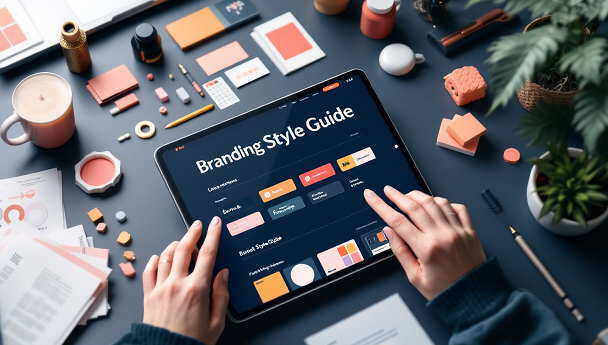Ever looked at a brand and instantly recognized it—without even seeing the name? That’s the power of consistent branding. Whether you’re just starting out or leading a growing team, having a brand style guide makes your business look professional, trustworthy, and cohesive across every platform.
So, what exactly is a brand style guide?
Think of it as your brand’s personal rulebook. It defines how your brand looks, feels, and communicates. It’s not just for designers or marketers—anyone on your team, from content creators to developers, benefits from having a clear visual and verbal direction.
Why You Need a Brand Style Guide
Let’s be real—without guidelines, brand messaging can quickly become inconsistent. One version of the logo here, a completely different color scheme there… and before you know it, your brand starts to feel disconnected.
Here’s what a solid brand style guide does for you:
- Keeps your visuals and voice consistent
- Saves time when creating new content
- Makes onboarding easier for new team members
- Builds a strong, unified brand presence
- Helps your business feel bigger and more established—even if you’re just one person
At Digiverse Studio, we’ve seen countless brands level up just by organizing their style guide properly. It doesn’t have to be complicated—it just needs to be clear.
Key Elements to Include in Your Brand Style Guide
Let’s walk through what you actually need to include. No fluff—just the essentials that make a difference.
1. Your Logo and Its Rules
Show how your logo should be used—full color, black-and-white, icon-only. Include spacing rules and examples of what not to do. This keeps your logo looking clean and professional wherever it appears.
2. Color Palette
Choose a set of core colors that reflect your brand. Include exact color codes (HEX, RGB, CMYK) to keep things consistent whether you’re designing for digital or print.
3. Typography
Fonts are more than just letters—they give your brand personality. Pick your heading, subheading, and body fonts, and outline the sizes, weights, and styles. Clean typography can elevate your entire brand feel.
4. Image and Visual Style
Are you using vibrant photos, moody tones, clean line icons, or custom illustrations? Define your style and include a few do’s and don’ts. This is especially helpful for social media and web design.
5. Tone of Voice
Your brand speaks even when you’re not in the room. Decide if you’re casual and friendly, bold and confident, or formal and informative. Include a few tone guidelines and maybe even example sentences.
6. Design Elements and Patterns
If you use specific shapes, textures, or graphic accents—like a wave motif or dashed underline—make sure they’re documented with usage examples.
7. Brand in Action
Include mockups or real-life examples—like a business card, social post, or landing page—that show your style guide in use. This helps your team (and future designers) understand how it all ties together.
Practical Branding Tips to Make It Stick
Creating a style guide is one thing—using it is another. Here are a few simple tips to make sure your brand stays aligned:
- Store it in the cloud so it’s accessible to your team
- Revisit it every 6–12 months and update as needed
- Add real-life use cases, not just rules
- Share it with freelancers and partners to stay on-brand
Remember, your brand style guide doesn’t need to be overly complex. Keep it simple, clear, and useful. The goal is to help everyone—from your social media manager to your web designer—create content that feels like your brand, every time.
In the end, creating a thoughtful style guide is one of the smartest branding tips you can implement early on. It’s the kind of behind-the-scenes work that makes your business look polished, professional, and intentional. Whether you’re rebranding or starting fresh, your guide becomes the glue that holds your visual identity together.
Start with the basics, stay consistent, and your brand will speak louder—without ever saying a word.

